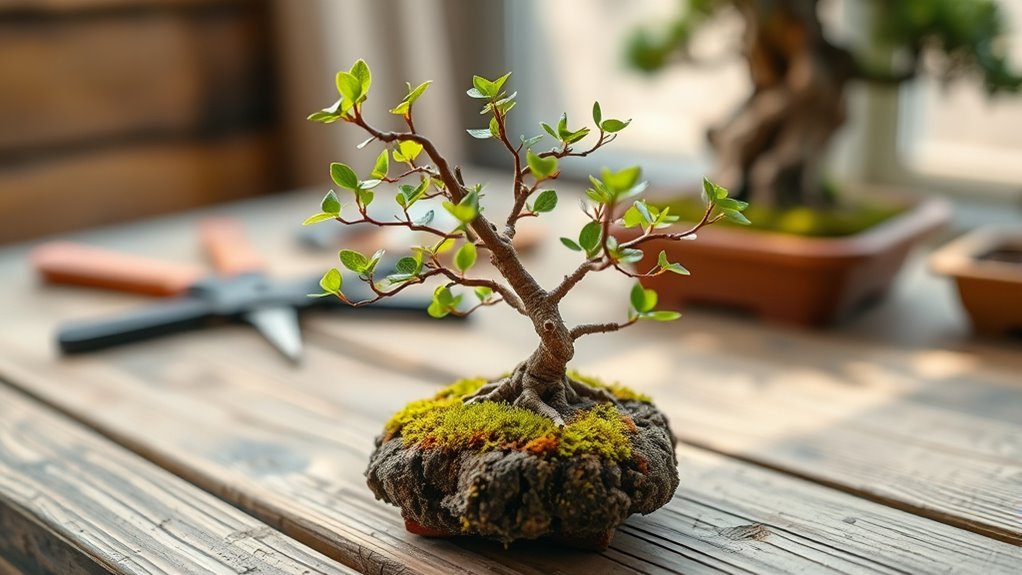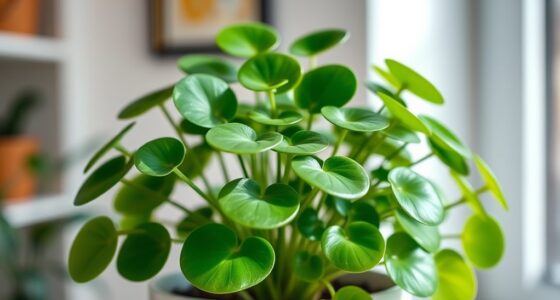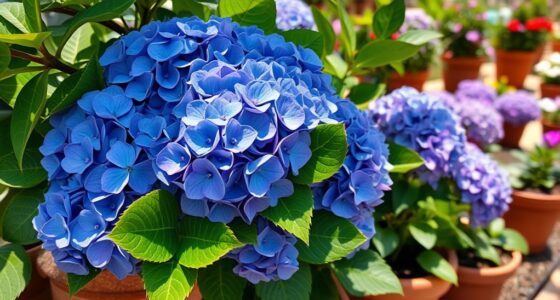To start caring for your bonsai, focus on proper watering—keep soil slightly moist but not soggy, watering thoroughly when needed. Use well-draining soil and prune regularly to remove dead branches and shape the tree. Pinch back new growth to maintain your desired style. Balancing watering and pruning helps your bonsai stay healthy and look beautiful. Keep practicing and adjusting your techniques to develop your skill—more tips ahead will help you master this art.
Key Takeaways
- Water your bonsai regularly, ensuring the soil stays slightly moist without becoming soggy.
- Use well-draining soil and ensure proper drainage to prevent root rot and promote healthy growth.
- Prune dead, crossing, or overly long branches to improve airflow and shape the bonsai effectively.
- Pinch back new growth periodically to maintain the desired style and prevent elongation.
- Maintain a consistent watering and pruning routine, adjusting for seasons to support healthy development.

Creating a bonsai tree is both an art and a science, requiring patience and attention to detail. When you’re starting out, one of the most important aspects to master is proper watering. Unlike regular houseplants, bonsais need a carefully managed watering schedule to thrive. You don’t want to overwater, which can lead to root rot, or underwater, which causes dehydration. The key is to check the soil daily; it should feel slightly moist but not soggy. During warmer months or in dry environments, you might find yourself watering more frequently—sometimes daily—while in cooler months, every few days might suffice. Always use well-draining soil to prevent excess water from stagnating around the roots. When watering, do so thoroughly until water drips out of the drainage holes, ensuring the entire root ball gets hydrated. This consistent approach helps keep your bonsai healthy and vigorous. Incorporating protective styling benefits into your bonsai care might seem unusual, but it emphasizes the importance of maintaining the health and safety of the plant’s delicate structure.
Pruning techniques are equally critical in shaping your bonsai and maintaining its health. Proper pruning encourages new growth, improves the tree’s shape, and prevents it from becoming overgrown. When you prune, focus on removing dead or crossing branches first, as these can hinder airflow and promote disease. Use sharp, clean scissors or pruning shears to make precise cuts, which minimizes damage and speeds healing. Regular pruning involves both branch trimming and root pruning, especially when repotting, to keep the tree compact and manageable. When shaping your bonsai, start with light pruning and gradually work toward more detailed work as the tree develops. Pinching back new growth with your fingers or small scissors can help maintain the desired style and prevent excessive elongation. Remember, less is often more—over-pruning can stress the plant, so always aim for a balanced, natural appearance. As you gain experience, you’ll learn to read your bonsai’s unique needs and adjust your pruning techniques accordingly.
In essence, caring for a bonsai involves a delicate balance of watering and pruning. Your watering schedule should be consistent but adaptable based on the season and environment, ensuring your bonsai’s roots stay healthy without becoming waterlogged. Simultaneously, applying the right pruning techniques will shape your tree into a miniature masterpiece, encouraging growth in the desired direction. With patience and practice, these fundamental skills become second nature, allowing you to enjoy the process of nurturing and shaping your bonsai into a living work of art.
Frequently Asked Questions
How Often Should I Water My Bonsai?
When figuring out your watering schedule, you should check your bonsai’s moisture levels regularly. Water it whenever the soil feels dry a few inches below the surface, usually every day or every few days depending on your climate. Avoid overwatering, which can cause root rot. Keep an eye on the soil’s moisture, and adjust your watering frequency to maintain consistent, healthy moisture levels that support your bonsai’s growth.
What’s the Best Fertilizer for Beginner Bonsais?
Think of your bonsai as a delicate garden in miniature, needing just the right nourishment. For beginners, a balanced fertilizer like a liquid all-purpose or slow-release formula works best, supplying essential soil nutrients. These fertilizer types guarantee steady growth without overwhelming the tiny roots. Regular feeding, about once a month, keeps your bonsai vibrant and healthy, helping it flourish like a tiny tree reaching toward the sun.
How Do I Prevent Pests on My Bonsai?
To prevent pests on your bonsai, start by regularly inspecting it for pest identification issues. Keep your plant healthy through proper watering and fertilizing, which makes it less attractive to pests. Use natural remedies like neem oil or insecticidal soap to treat infestations early. Quarantine new plants before introducing them to your bonsai, and maintain good airflow around your plant to reduce pest risks.
When Is the Optimal Time to Prune?
You should prune during the plant’s growth cycle, ideally in early spring or late summer, to promote healthy development. Seasonal pruning aligns with your bonsai’s growth cycle, helping control shape and size. Avoid heavy pruning during dormancy or extreme weather. Regularly monitor new growth, trimming back extensions to maintain your desired shape. This guarantees your bonsai stays healthy, balanced, and visually appealing throughout its seasonal growth cycle.
Can I Keep a Bonsai Indoors Year-Round?
You can keep a bonsai indoors year-round if you provide the right indoor environment. It’s important to make seasonal adjustments, like increasing humidity and adjusting watering habits during winter. Place your bonsai in a bright spot away from direct sunlight and drafts. Regularly monitor temperature and humidity levels, and consider using a humidity tray. With proper care and seasonal adjustments, your bonsai can thrive indoors throughout the year.
Conclusion
Starting your bonsai journey is both rewarding and calming. With patience and care, you’ll see your miniature tree thrive and take on its own unique character. Did you know that bonsai cultivation dates back over a thousand years? That tradition proves how this art form combines patience, skill, and tradition. So, keep learning, stay dedicated, and enjoy the serenity and beauty your bonsai brings into your life. Your miniature masterpiece is just a care routine away!









